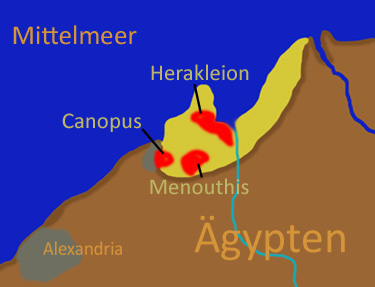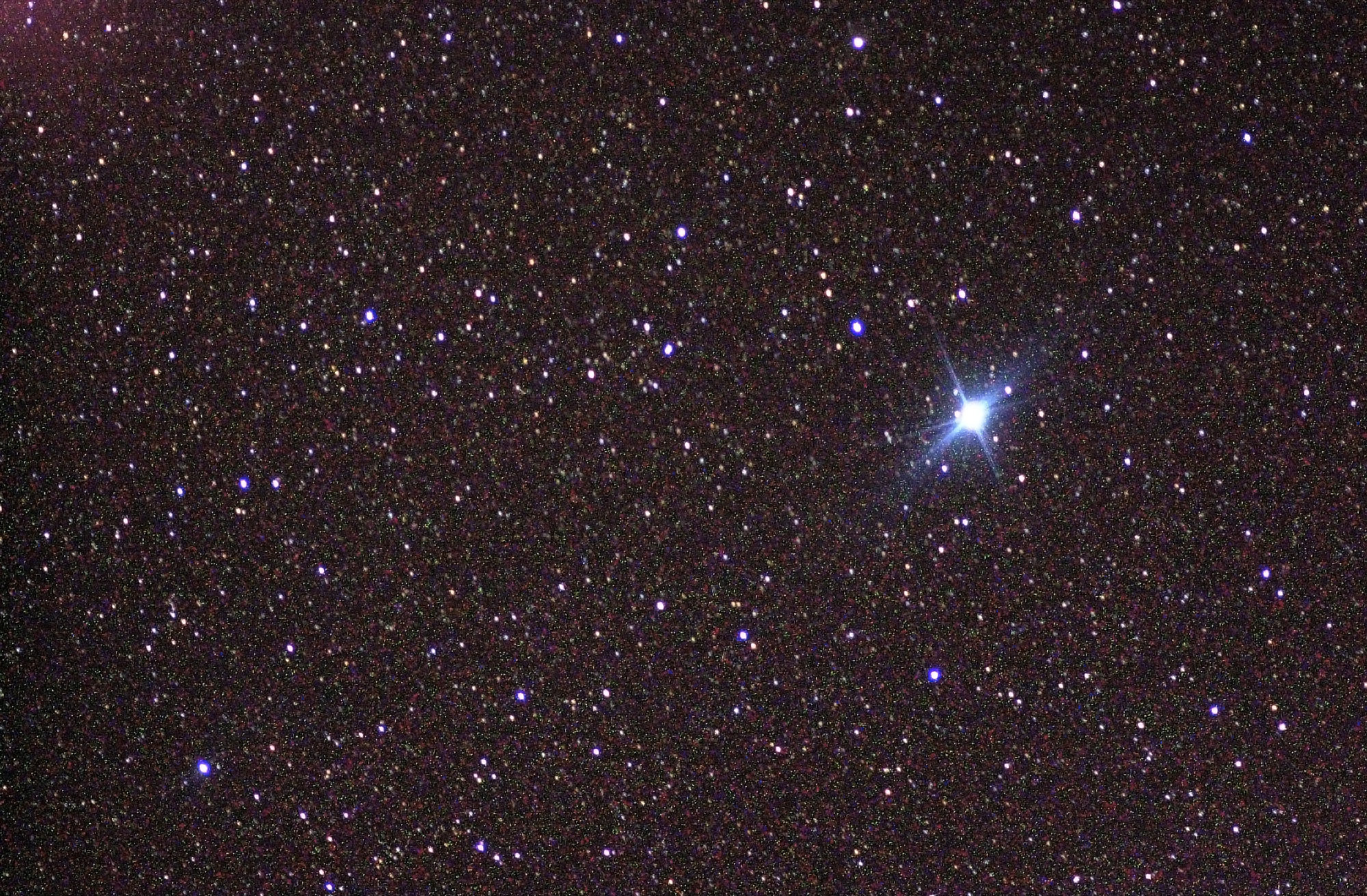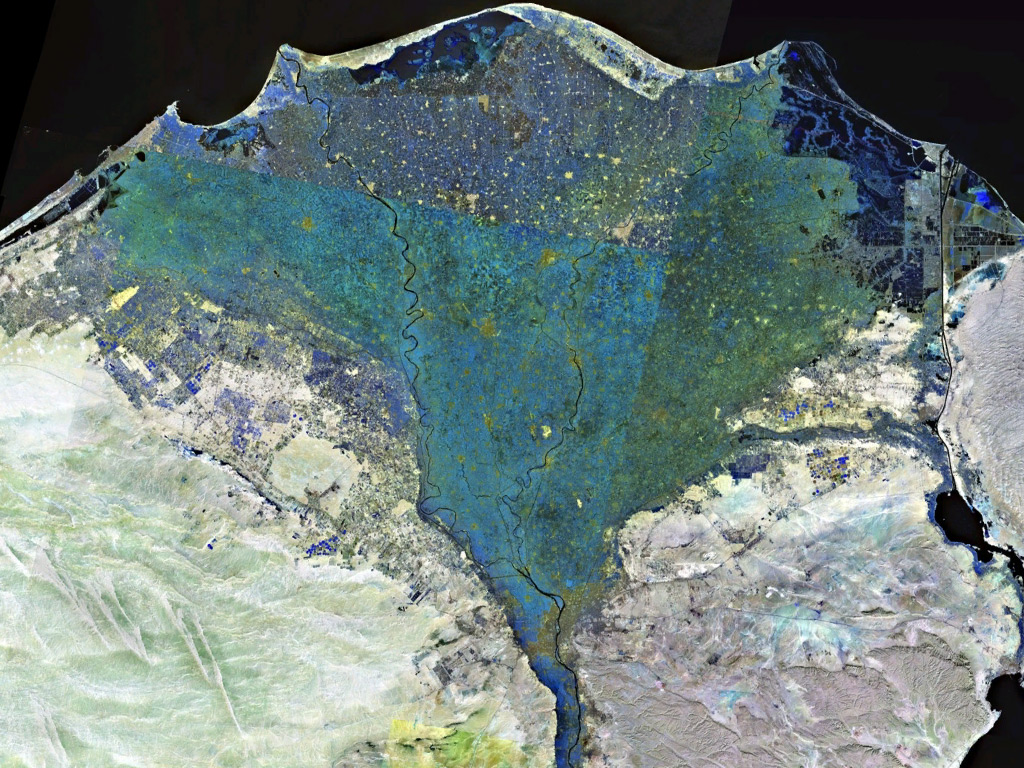|
Aboukir Bay
The Abū Qīr Bay (sometimes transliterated Abukir Bay or Aboukir Bay) (; Arabic transliteration, transliterated: Khalīj Abū Qīr) is a spacious bay on the Mediterranean Sea near Alexandria in Egypt, lying between the Rosetta mouth of the Nile and the town of Abu Qir. The ancient cities of Canopus (Egypt), Canopus, Heracleion and Menouthis lie submerged beneath the waters of the bay. In 1798 it was the site of the Battle of the Nile, a naval battle fought between the British Royal Navy and the navy of the French First Republic. The bay contains a natural gas field, discovered in the 1970s. Geography Abu Qir Bay lies approximately east of Alexandria, bounded to the southwest by the Abu Qir headland, on which lies the town of Abu Qir, and to the northeast by the Rosetta mouth of the Nile. The bay is a highly fertile Egyptian coastal region but suffers from acute eutrophication and pollution from untreated industrial and domestic waste. The ABU QIR Fertilizers and Chemicals Industr ... [...More Info...] [...Related Items...] OR: [Wikipedia] [Google] [Baidu] |
Beheira Governorate
Beheira Governorate ( ar, محافظة البحيرة ', , "the governorate of the Lake") is a coastal governorate in Egypt. Located in the northern part of the country in the Nile Delta, its capital is Damanhur. Overview Beheira Governorate enjoys an important strategical place, west of the Rosetta branch of the Nile. It comprises four important highways, namely the Cairo-Alexandria desert road, the Cairo agricultural road, the international road, and the circular road. Beheira Governorate is also home to a number of the most important Coptic monasteries in Wadi El Natrun (Scetes). Beheira consists of 13 centers and 14 cities, and contains important industries such as cotton, chemicals, carpets, electricity, and fishing. The governorate has a noteworthy number of archaeological sites, including at Abu El Matamir, Abu Hummus, Damanhour, Rosetta (Rashid), and Kafr El Dawwar. Coins, lamps, animal bones, and pottery from Roman and later Eastern Roman (Byzantine) eras are some ... [...More Info...] [...Related Items...] OR: [Wikipedia] [Google] [Baidu] |
French First Republic
In the history of France, the First Republic (french: Première République), sometimes referred to in historiography as Revolutionary France, and officially the French Republic (french: République française), was founded on 21 September 1792 during the French Revolution. The First Republic lasted until the declaration of the First Empire on 18 May 1804 under Napoléon Bonaparte, although the form of the government changed several times. This period was characterized by the fall of the monarchy, the establishment of the National Convention and the Reign of Terror, the Thermidorian Reaction and the founding of the Directory, and, finally, the creation Creation may refer to: Religion *''Creatio ex nihilo'', the concept that matter was created by God out of nothing * Creation myth, a religious story of the origin of the world and how people first came to inhabit it * Creationism, the belief tha ... of the French Consulate, Consulate and Napoleon's rise to power. End of the m ... [...More Info...] [...Related Items...] OR: [Wikipedia] [Google] [Baidu] |
Neshmet
The Neshmet bark was a vessel belonging to the god Nun. The ancient Egyptian deity Osiris was transported in it on the river Nile during the Osiris festival at Abydos. The god's departure from his temple, journey to his tomb, and triumphant return were enacted and drew many spectators who participated in the public parts of the mysteries. In myth The myth of the death and resurrection of Osiris kindled hope for eternal life in the hearts of the believers, and since the 6th dynasty they often preferred to be buried near their god at Abydos. Their mummies were taken to the city in decorated funerary boats reminiscent of Osiris' Neshmet bark. Involvement in building a Neshmet bark was an event of some importance and duly recorded among the good deeds in a person's 'autobiographical' mortuary inscriptions. Tomb depictions show the deceased in Neshmet barks, thus Rekhmire's statue is shown in a shrine on the bark with a priest making libations. Other divine barks There were other divi ... [...More Info...] [...Related Items...] OR: [Wikipedia] [Google] [Baidu] |
Ptolemy II
; egy, Userkanaenre Meryamun Clayton (2006) p. 208 , predecessor = Ptolemy I , successor = Ptolemy III , horus = ''ḥwnw-ḳni''''Khunuqeni''The brave youth , nebty = ''wr-pḥtj''''Urpekhti''Great of strength , golden = ''šḫꜤj-n-sw it.f''''Shekhaiensu itef''Whose father enthroned him , prenomen = ''wsr-kꜢ-rꜤ mrj-jmn''''Userkare Meryamun''The strong one of the ka of Ra, beloved of Amun , nomen = ''ptwꜢlwmys''''Petualumys''Ptolemaios , nomen_hiero = p:t-wA-l:M-i-i-s , birth_date = c.309 BC , birth_place = Kos , death_date = 28 January 246 BC (aged 62–63) , spouse = Arsinoe IArsinoe II , children = With Arsinoe I: Ptolemy IIILysimachus Berenice, Queen of SyriaWith Bilistiche:Ptolemy Andromachou , dynasty = Ptolemaic dynasty , father = Ptolemy I , mother = Berenice I Ptolemy II Philadelphus ( gr, Πτολεμαῖος Φιλάδελφος ''Ptolemaios Philadelphos'', "Ptolemy, sibling-lover" ... [...More Info...] [...Related Items...] OR: [Wikipedia] [Google] [Baidu] |
Franck Goddio
Franck Goddio (born 1947 in Casablanca, Morocco) is a French underwater archaeologist who, in 2000, discovered the city of Thonis-Heracleion 7 km off the Egyptian shore in Aboukir Bay. He led the excavation of the submerged site of Canopus and of Antirhodos in the ancient harbour of Alexandria (''Portus Magnus''). He has also excavated ships in the waters of the Philippines, significantly the Spanish galleon ''San Diego''. Biography Goddio received degrees in mathematics and statistics from the École Nationale de la Statistique et de l'Administration Économique in Paris. He was employed as an advisor to national and international organizations and various governments for over 15 years. In the early 1980s he decided to focus on underwater archaeology. In 1987 he founded the Institut Européen d'Archéologie Sous-Marine (IEASM) in Paris. In his work in detecting and recovering ancient shipwrecks and searching for the remains of sunken cities, Goddio developed a systematic a ... [...More Info...] [...Related Items...] OR: [Wikipedia] [Google] [Baidu] |
Canopus, Egypt
Canopus (, ; grc-gre, Κάνωπος, ), also known as Canobus ( grc-gre, Κάνωβος, ), was an ancient Egyptian coastal town, located in the Nile Delta. Its site is in the eastern outskirts of modern-day Alexandria, around from the center of that city. Canopus was located on the western bank at the mouth of the westernmost branch of the Delta – known as the Canopic or Heracleotic branch. It belonged to the seventh Egyptian Nome, known as ''Menelaites'', and later as ''Canopites'', after it. It was the principal port in Egypt for Greek trade before the foundation of Alexandria, along with Naucratis and Heracleion. Its ruins lie near the present Egyptian town of Abu Qir. Land in the area of Canopus was subject to rising sea levels, earthquakes, tsunamis, and large parts of it seem to have succumbed to liquefaction sometime at the end of the 2nd century BC. The eastern suburbs of Canopus collapsed, their remains being today submerged in the sea, with the western suburbs ... [...More Info...] [...Related Items...] OR: [Wikipedia] [Google] [Baidu] |
Canopus Menouthis Herakleion
Canopus is the brightest star in the southern constellation of Carina and the second-brightest star in the night sky. It is also designated α Carinae, which is Latinised to Alpha Carinae. With a visual apparent magnitude of −0.74, it is outshone only by Sirius. Located around from the Sun, Canopus is a bright giant of spectral type A9, so it is essentially white when seen with the naked eye. It has a luminosity over 10,000 times the luminosity of the Sun, is eight times as massive, and has expanded to 71 times the Sun's radius. Its enlarged photosphere has an effective temperature of around . Canopus is undergoing core helium burning and is currently in the so-called blue loop phase of its evolution, having already passed through the red-giant branch after exhausting the hydrogen in its core. Canopus is a source of X-rays, which are likely being emitted from its corona. The prominent appearance of Canopus means it has been the subject of mythological ... [...More Info...] [...Related Items...] OR: [Wikipedia] [Google] [Baidu] |
Soil Liquefaction
Soil liquefaction occurs when a cohesionless saturated or partially saturated soil substantially loses strength and stiffness in response to an applied stress such as shaking during an earthquake or other sudden change in stress condition, in which material that is ordinarily a solid behaves like a liquid. In soil mechanics, the term "liquefied" was first used by Allen Hazen in reference to the 1918 failure of the Calaveras Dam in California. He described the mechanism of flow liquefaction of the embankment dam as: The phenomenon is most often observed in saturated, loose (low density or uncompacted), sandy soils. This is because a loose sand has a tendency to compress when a load is applied. Dense sands, by contrast, tend to expand in volume or 'dilate'. If the soil is saturated by water, a condition that often exists when the soil is below the water table or sea level, then water fills the gaps between soil grains ('pore spaces'). In response to soil compressing, the po ... [...More Info...] [...Related Items...] OR: [Wikipedia] [Google] [Baidu] |
Tsunami
A tsunami ( ; from ja, 津波, lit=harbour wave, ) is a series of waves in a water body caused by the displacement of a large volume of water, generally in an ocean or a large lake. Earthquakes, volcanic eruptions and other underwater explosions (including detonations, landslides, glacier calvings, meteorite impacts and other disturbances) above or below water all have the potential to generate a tsunami. Unlike normal ocean waves, which are generated by wind, or tides, which are in turn generated by the gravitational pull of the Moon and the Sun, a tsunami is generated by the displacement of water from a large event. Tsunami waves do not resemble normal undersea currents or sea waves because their wavelength is far longer. Rather than appearing as a breaking wave, a tsunami may instead initially resemble a rapidly rising tide. For this reason, it is often referred to as a tidal wave, although this usage is not favoured by the scientific community because it might give ... [...More Info...] [...Related Items...] OR: [Wikipedia] [Google] [Baidu] |
Geoarchaeology
Geoarchaeology is a multi-disciplinary approach which uses the techniques and subject matter of geography, geology, geophysics and other Earth sciences to examine topics which inform archaeological knowledge and thought. Geoarchaeologists study the natural physical processes that affect archaeological sites such as geomorphology, the formation of sites through geological processes and the effects on buried sites and artifacts post-deposition. Geoarchaeologists' work frequently involves studying soil and sediments as well as other geographical concepts to contribute an archaeological study. Geoarchaeologists may also use computer cartography, geographic information systems (GIS) and digital elevation models (DEM) in combination with disciplines from human and social sciences and earth sciences. Geoarchaeology is important to society because it informs archaeologists about the geomorphology of the soil, sediment, and rocks on the buried sites and artifacts they are researching. B ... [...More Info...] [...Related Items...] OR: [Wikipedia] [Google] [Baidu] |
Nile Delta
The Nile Delta ( ar, دلتا النيل, or simply , is the delta formed in Lower Egypt where the Nile River spreads out and drains into the Mediterranean Sea. It is one of the world's largest river deltas—from Alexandria in the west to Port Said in the east, it covers of Mediterranean coastline and is a rich agricultural region. From north to south the delta is approximately in length. The Delta begins slightly down-river from Cairo. Geography From north to south, the delta is approximately in length. From west to east, it covers some of coastline. The delta is sometimes divided into sections, with the Nile dividing into two main distributaries, the Damietta and the Rosetta, flowing into the Mediterranean at port cities with the same name. In the past, the delta had several distributaries, but these have been lost due to flood control, silting and changing relief. One such defunct distributary is Wadi Tumilat. The Suez Canal is east of the delta and enters the coa ... [...More Info...] [...Related Items...] OR: [Wikipedia] [Google] [Baidu] |
Nitrogen Fertilizer
A fertilizer (American English) or fertiliser (British English; see spelling differences) is any material of natural or synthetic origin that is applied to soil or to plant tissues to supply plant nutrients. Fertilizers may be distinct from liming materials or other non-nutrient soil amendments. Many sources of fertilizer exist, both natural and industrially produced. For most modern agricultural practices, fertilization focuses on three main macro nutrients: nitrogen (N), phosphorus (P), and potassium (K) with occasional addition of supplements like rock flour for micronutrients. Farmers apply these fertilizers in a variety of ways: through dry or pelletized or liquid application processes, using large agricultural equipment or hand-tool methods. Historically fertilization came from natural or organic sources: compost, animal manure, human manure, harvested minerals, crop rotations and byproducts of human-nature industries (i.e. fish processing waste, or bloodmeal from a ... [...More Info...] [...Related Items...] OR: [Wikipedia] [Google] [Baidu] |






